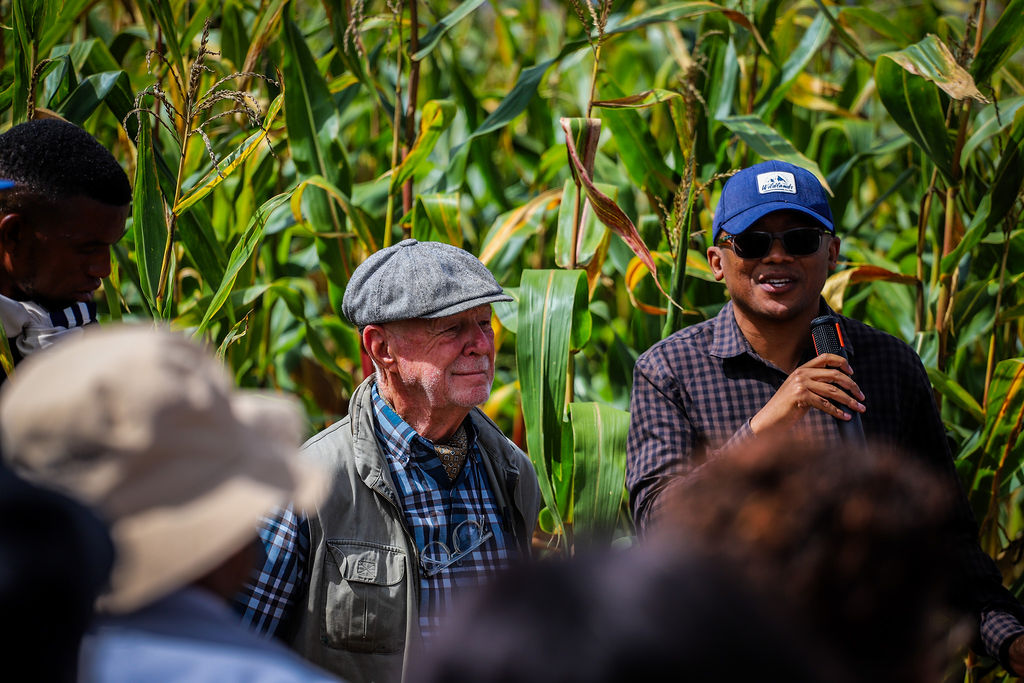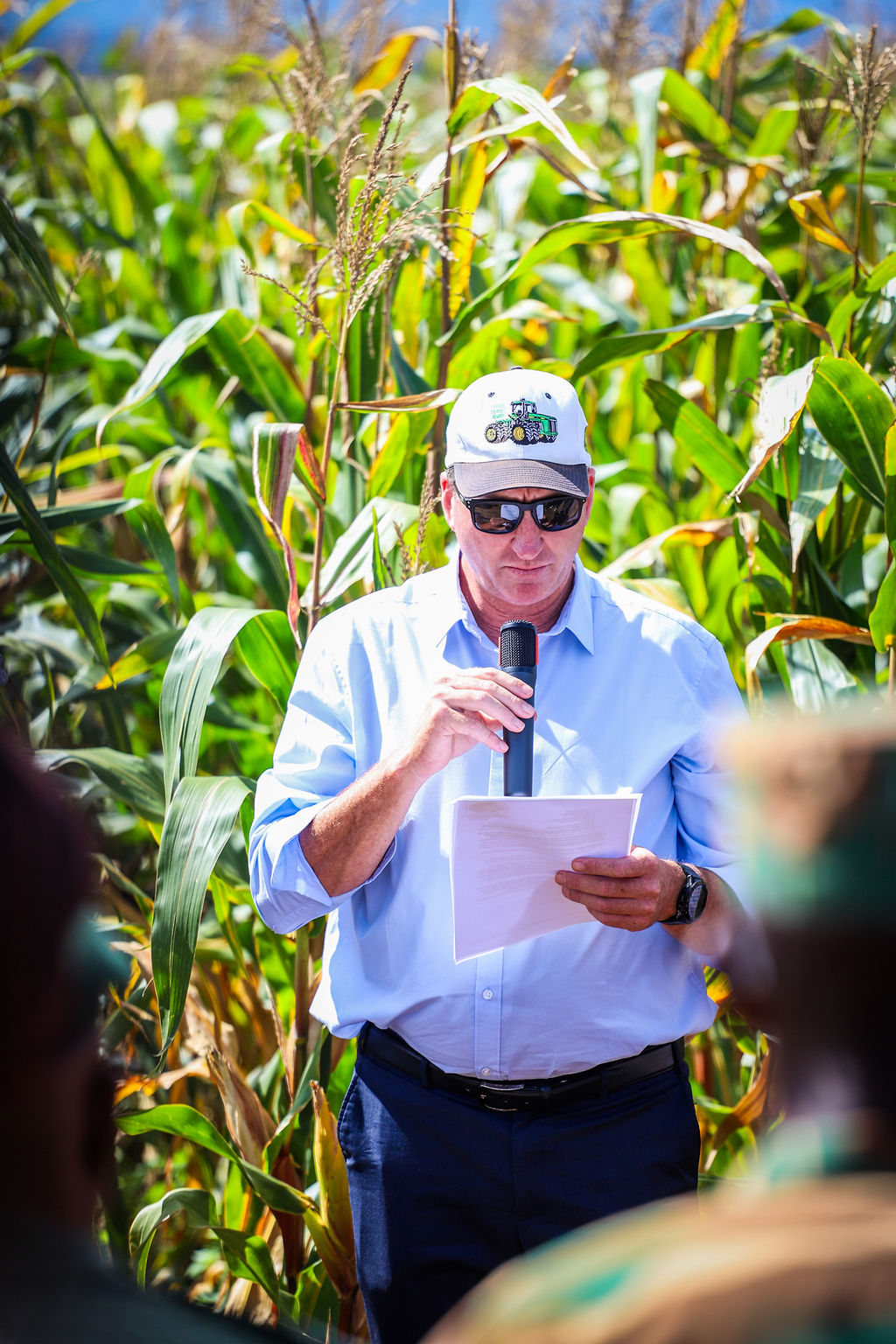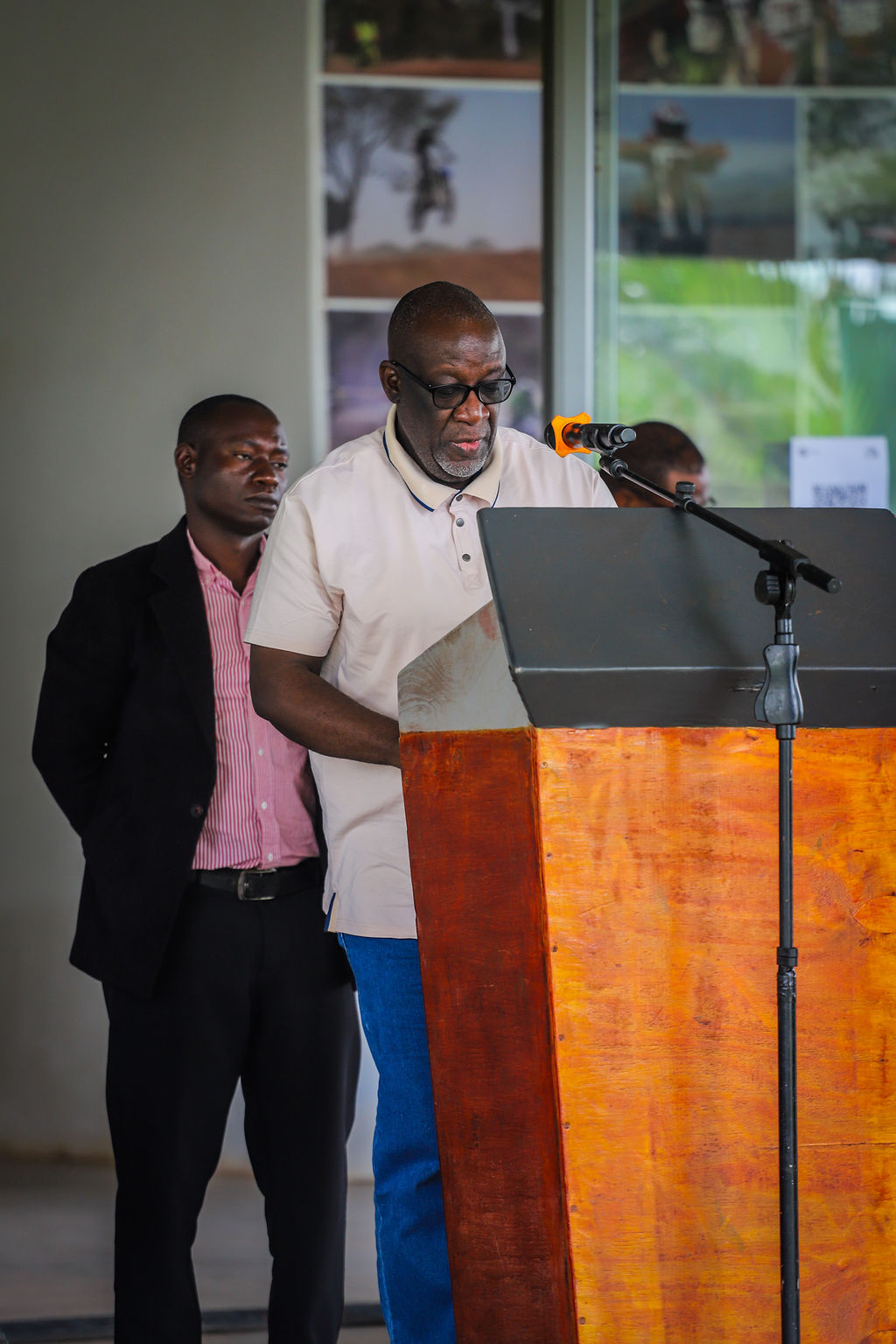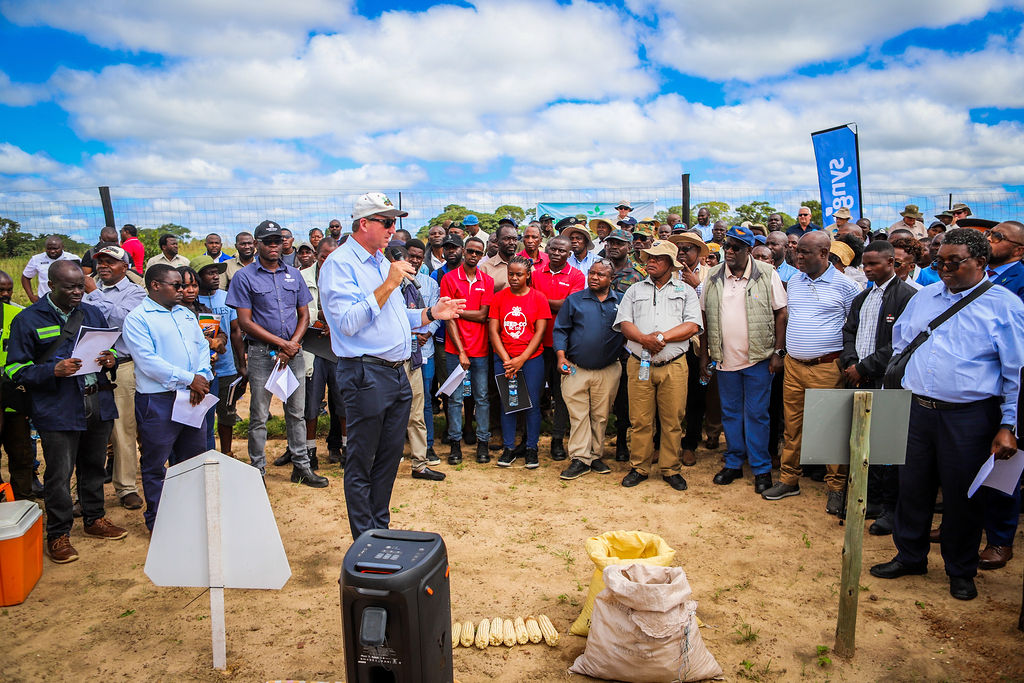CPTM’s new initiative – being developed with countries in southern and eastern Africa – will identify and execute high impact, commercially scaleable projects to transform the climate smart practices, yields and profitability of small-holder farmers.
Food Security
ENHANCING FOOD SECURITY, CONSERVING NATURAL RESOURCES

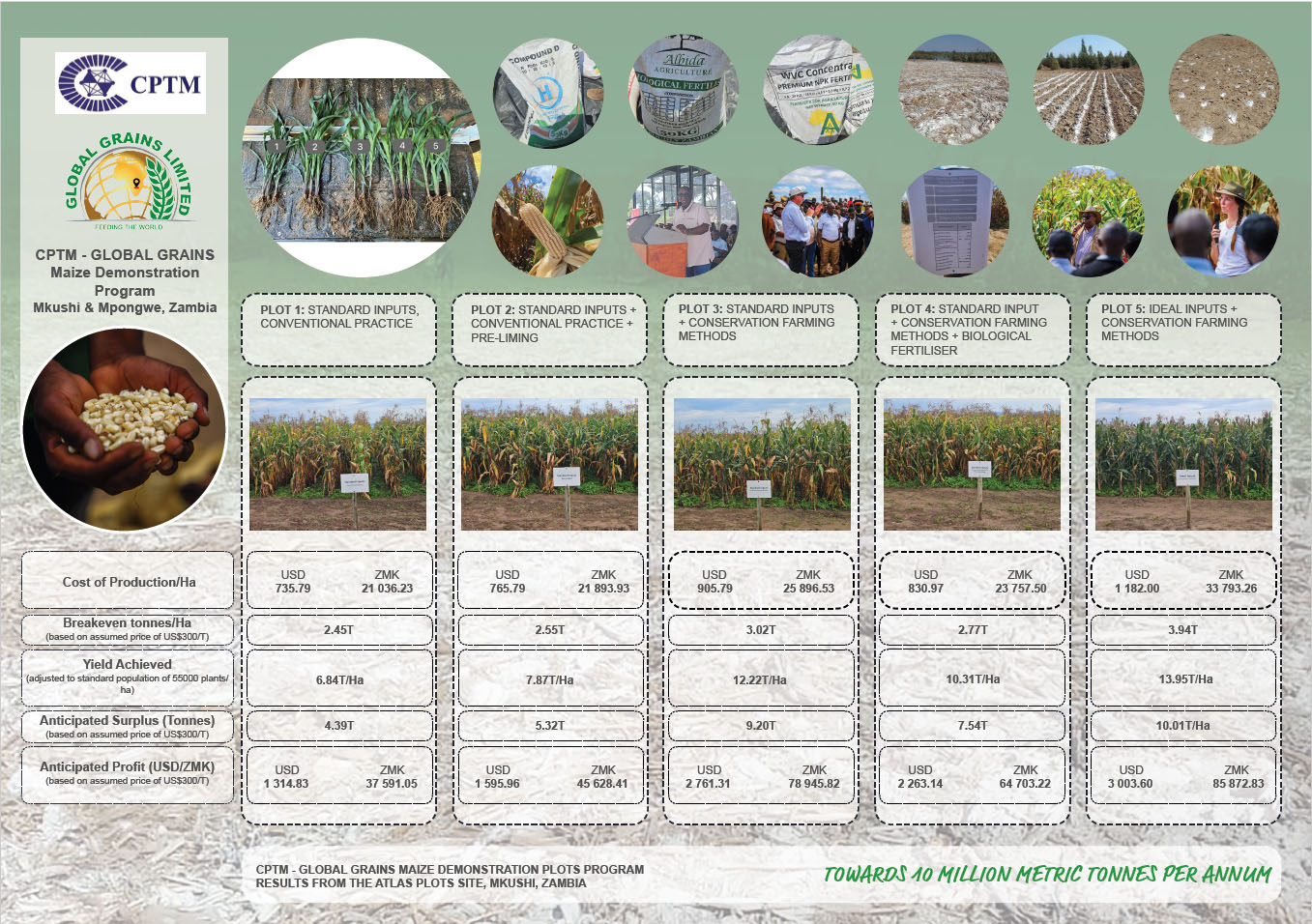
Global Grains Results
Advancing Food Security: CPTM and Global Grains Showcase Transformative Maize Demonstration Results in Zambia
Mkushi, Zambia – March 18, 2025
In a significant demonstration of agricultural innovation and strategic partnership, the Commonwealth Partnership for Technology Management (CPTM) and Global Grains Investment Limited recently convened a high-level Maize Trial Field Day in Mkushi, Zambia on Tuesday 18 March 2025. This pivotal event underscored the tangible progress being made towards enhancing food security and agricultural productivity particularly amongst small-holder farmers.
The gathering attracted a distinguished cohort of decision-makers, including senior government officials, diplomatic representatives, leaders from financial institutions, agricultural experts, and key figures from both commercial and small-scale farming communities. The broad representation at the field day highlights the collective commitment to bolstering Zambia’s agricultural sector and its ambitious goal of elevating annual maize production to 10 million metric tonnes per annum.
Since its establishment in 1995, CPTM has been dedicated to fostering economic advancement in Commonwealth and beyond through the judicious management of technology and innovation, often via public-private sector collaborations. This ethos is exemplified by the impactful partnership forged in 2024 with Global Grains, a Zambian-registered entity guided by Stewart Parkes, a fourth-generation farmer with a profound legacy in agriculture and research. The collaboration is rooted in a shared imperative to address regional food insecurity through the development of productive small-scale farming practices.
The maize demonstrations, meticulously designed and executed, focused on critical interventions: the influence of liming on soil health, the efficacy of conservation farming practices, and the optimization of returns on investment. These investigations aim to promote sustainable farming methods capable of withstanding sub-optimal conditions and ensuring greater food security amidst seasonal challenges.
Five distinct trial plots at the three distinct sites showcased varied agricultural methodologies, providing a comparative analysis of their respective outcomes:
Plot 1: Conventional Practice (Control): Employing standard inputs and traditional cultivation methods, this plot served as the baseline.
Plot 2: Pre-Limed Conventional Practice: Identical to the control, but with the strategic addition of lime at a rate of 500kg per hectare prior to sowing, addressing the region’s inherently low soil pH.
Plot 3: Conservation Method: This plot rigorously applied conservation farming principles — minimum tillage, zero burning, and mulching — alongside standard inputs and a lime application.
Plot 4: Conservation with Biologicals: This plot integrated conservation farming with an organic, compost-based fertilizer (Albida Biofert) and a microbiological seed dressing, aiming to enhance soil biology and reduce production costs.
Plot 5: Ideal Inputs, Conservation Method: Representing a commercially optimized approach based on Stewart Parkes’ extensive experience, this plot utilized premium seed varieties (Pannar PAN7M-83), specialized fertilizers (WVC), and comprehensive top-dressings, all within a conservation farming framework.
Preliminary findings from the trials present compelling evidence of the profound impact of these agricultural interventions. While full yield data is still being compiled, indicative samples revealed significant improvements. For instance, the Katuba Village plots demonstrated a yield difference of over 1.8 tonnes per hectare between the standard conventional practice and the pre-limed conventional practice, underscoring the immediate benefits of lime application, particularly in low pH soils which are characteristic across Sub-Saharan Africa.
Crucially, the exercise highlighted several key points for consideration by policymakers and agricultural stakeholders:
- Liming as a Fundamental Enabler: The application of agricultural lime not only corrects soil acidity but profoundly enhances Cation Exchange Capacity (C.E.C.), nutrient solubility, and overall soil fertility, providing a foundational improvement for crop development.
- Conservation Farming’s Dual Dividend: Practices such as minimum tillage, zero burning, correct plant populations, and optimized cultivation areas yield substantial improvements in crop resilience and resource utilization, offering cost-free yet highly effective methods accessible to farmers regardless of their scale or financial standing.
- The Promise of Soil Biology: Integrating microbiological products can significantly mitigate the adverse effects of heat and water stress, fostering sustainable agricultural practices that ensure healthy soils for sustained, generational production.
- Strategic Investment for Enhanced Returns: While higher costs of production may be incurred through the acquisition of high-quality, regionally suitable inputs, the trials unequivocally demonstrate that these investments translate into yields significantly above average, leading to improved returns on investment and greater profit margins.
During the field day, CPTM Director John Carter emphasized that the commercial farmers in Zambia consistently achieved yields ranging from 10 to nearly 14 tonnes per hectare, dramatically exceeding the national average of 1.5 tonnes per hectare. This success, he noted, offers smallholder farmers substantial scope to enhance their maize cultivation methods by adopting lessons used in some of the commercial settings. Dr. Oliver Kalabo, Deputy Secretary to the Cabinet and fellow Smart Partner, articulated the direct alignment of these trial results with President Hakainde Hichilema’s vision of achieving 10 million tonnes per annum of maize production by 2030. He underscored the potential by highlighting that if two million small-scale farmers could achieve a modest yield of 5 tonnes per hectare, Zambia would already meet its 10-million-tonne target. This statement galvanised all in attendance to be appreciate that the President’s vision is indeed achievable.
The CPTM-Global Grains initiative serves as a powerful testament to the transformative potential of targeted agricultural research and strategic partnerships. By prioritizing education, awareness, and the widespread implementation of sustainable farming practices, Zambia can significantly bolster its food security and emerge as a regional leader in agricultural output. The results of this exercise will be further engaged during a thematic Dialogue, which CPTM is organising in collaboration with Zambia’s Ministry of Agriculture. Slated to occur in Lusaka in July 2025, the Dialogue will bring together high-ranking government officials, members drawn from the commercial and small-scale agriculture value-chains, and representatives of the diplomatic community and development partners. The goal of this Dialogue is to agree on strategies to implement the practices revealed at the field day more widely across Zambia and adopt them as approaches to ensuring that the country’s agricultural production occurs at an optimal scale. The detailed data and financial summaries from the exercise are available for review. This initiative offers a compelling blueprint for agricultural resilience and prosperity across the region.
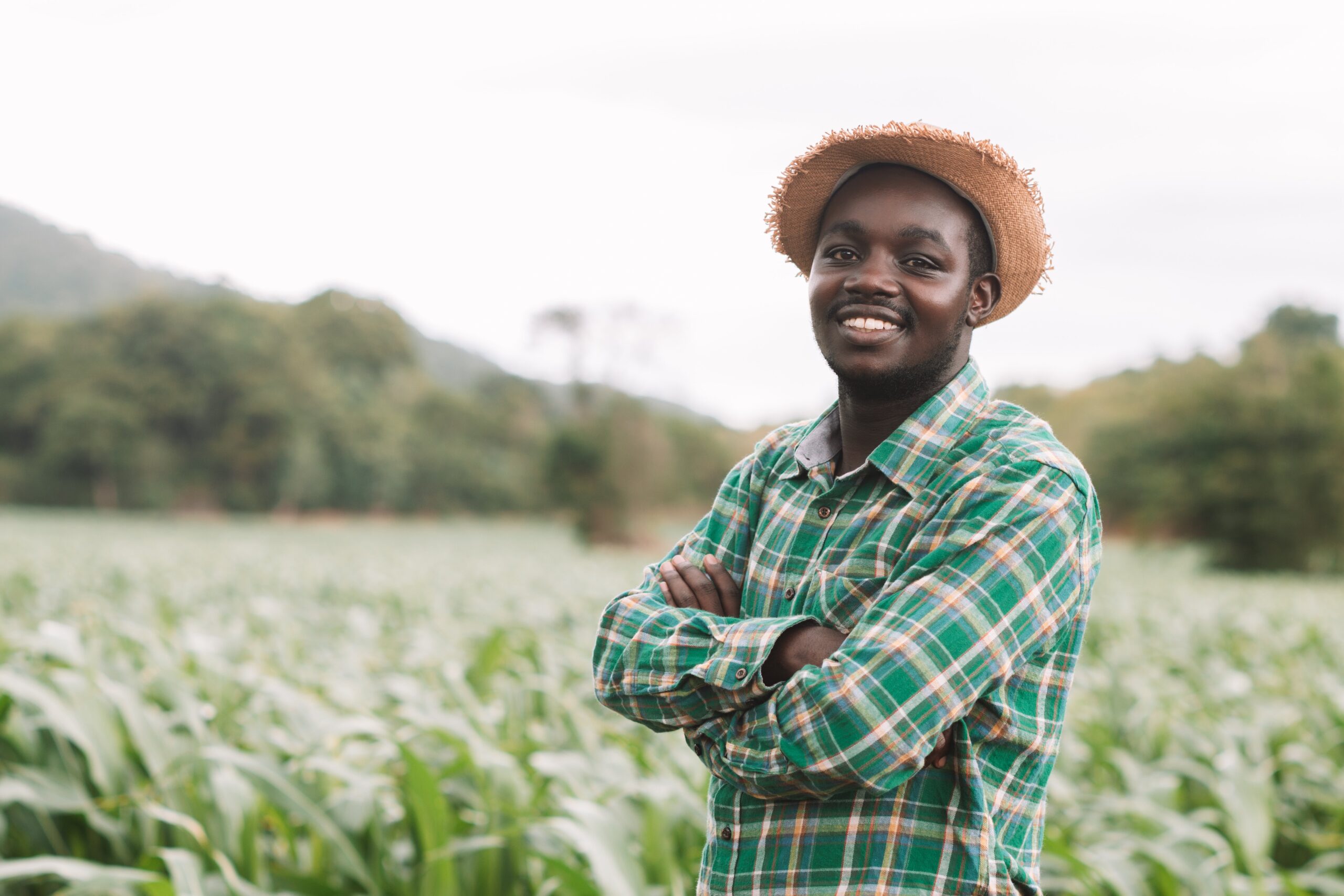

“Agricultural Productivity in Sub-Saharan Africa –The CPTM Smart Partnership Way”
THE CASE OF ZAMBIA
CPTM, represented by two of its directors, visited Lusaka, Zambia in May 2024. The purpose of the visit was to explore approaches which might improve the country’s agricultural productivity, currently characterised by low yields especially amongst small-holder farmers. The lessons learnt from this investigation, we believe, are also relevant for other countries in a similar predicament.
The visit established that many issues have bedevilled Smallholder operations where their numbers, dispersion and contribution to national production represents the major potential for uplift but also the major challenge.
The government’s Farmer’s Input Substitution Programme (FISP) currently subsidizes seed and fertiliser for over 1,000,000 farmers who cultivate one to two hectares each. These farmers and their families, usually produce 80% or about 3,000,000 tonnes of the country’s maize per year and similar amounts of other crops. However, the recent El Nino has reduced their maize production substantially to around 1,000,000 tonnes and depleted food stocks. This has forced Zambia to import food from elsewhere.
These farmers also face financial difficulties and drought induced low soil moisture levels that could affect their next season, which starts with the rains at the end of October. The most significant issue, however, is that the usual 3,000,000 tonnes on around 2 million hectares equates to an average maize yield of 1.7 tonnes per hectare amongst small holder farmers. This is only 15 – 20% of the 8-11 tonnes per hectare yield commercial farmers ordinarily achieve.
Below are the main challenges for agricultural productivity uncovered from the interactions during our visit and recommendations on how these can be best averted:
1. A major issue is ‘acidity’ or low soil pH which is endemic in much of Zambia and is exacerbated by over-cropping of land.
Many crops cannot use the fertilizer benefit to grow well in acidic soils.In this situation, the addition of lime is essential to improve soil quality and produce good yields. Research has long proven and is widely accepted in Zambian formal agriculture] that adding one tonne of lime per hectare can increase yields significantly and keep them high with regular liming. Although it can be the quickest way to improve soil quality, lime is bulky and seen as an extra expense.
CPTM Recommendation: That government explores options for distributing lime to smallholder farmers as a FISP input. For example, transport outwards on the empty trucks going to collect the crop could be used to ferry lime to farmers in time for spreading well ahead of planting.
2. From the information we gathered, FISP currently issues 1 standard fertilizer and seed type which may compromise yields where they are not matched to the soil profile and where the crop growth is compromised by stressed soil conditions especially if not mulched or interplanted to cover crops.
CPTM Recommendation: Adjust FISP to provide regionally appropriate inputs suited to specific soil & environmental conditions.
3. Smallholders constantly ‘overstretch and underproduce’.
In their eagerness to grow ‘more’, some small-scale farmers sow too big an area with the limited seed and fertiliser package. As a result, they have poor harvests.
CPTM Recommendation: Revise FISP to incorporate the Pfumvudza process, which includes soil testing and liming.
4. The Government Extension Services are supposed to help farmers with the best practices, but they face challenges including under-staffing, long distances and poor facilities in the field. This leads to a huge gap in the performance of the smallholders.
CPTM Recommendation: Utilize smartphone based digital technology with bi-directional communication to enhance operations. This would improve information flow, standards and ability to manage.
Also, encourage linkages between Commercial and Small-holder farmers through ‘hub and spoke’ arrangements where established commercial farmers can provide technical assistance to surrounding small-holder farmers.
CPTM thinks that the above suggestions can be implemented quickly before the next planting season begins. CPTM also thinks that a more rapid growth in productivity can be achieved in the medium and long term by using technologies such as artificial intelligence and machine learning and applying them to areas like seed development, agronomic practice and the delivery of extension services. These issues require discussion, cooperation and management to make them happen. To start this process, CPTM supports the hosting of a a National Dialogue on this subject with the aim of creating a common vision towards ensuring a secure long-term food future for Zambia.
1 In Mkushi in the recent drought, a test on adjacent 1-hectare plots with standard inputs versus a limed, matched fertiliser/seed and mulching method, produced yields of 360 kilos maize versus 4 tonnes; that is an 11:1 difference. In a normal season the test plot could have produced over 10 tonnes per hectare compared to the 1.7 tonnes currently produced. The amount of lime recommended is 1 tonne per hectare.
2 Pfumvudza plots are known to produce more than 650 kgs of maize over 625 square meters. This equates to more than 5 times the average Smallholder yield.
3 CPTM has established that at least one operation in Mkushi, though small in smallholder numbers, sets out a basic format to support, increase and promote the concept.


